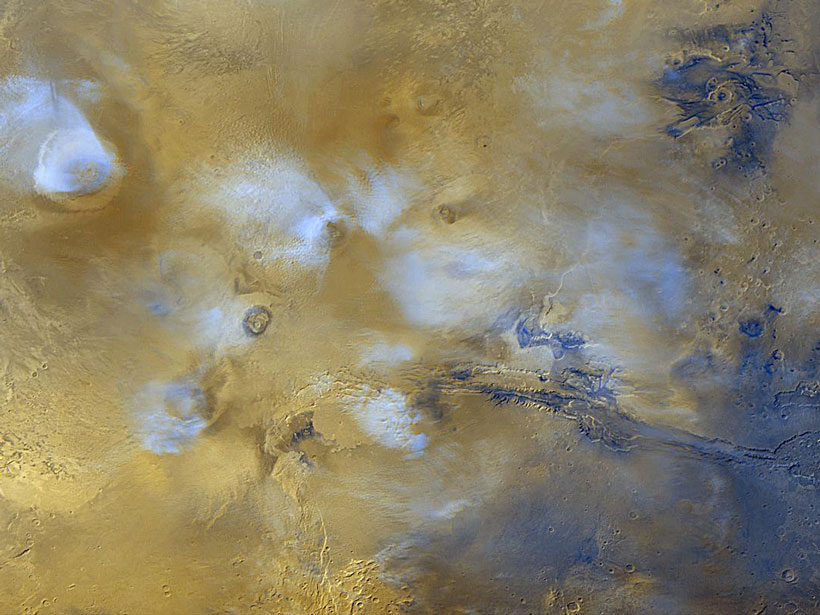Life might be the focus of Mars exploration today, but our planetary neighbor is the home to the largest volcanoes in the solar system. Olympus Mons towers 23 kilometers (75,000 feet) over the surrounding landscape, and its neighbors, the Tharsis Montes (Arsia Mons, Pavonis Mons, and Ascraeus Mons), stand out as a line of volcanic giants. These are the most prominent volcanic features on the planet, but a new study suggests the thousands of small volcanoes that litter the landscape are just as important to the volcanic history of Mars.
Small volcanoes are surprisingly important for understanding the volcanic history of a planet. On Earth, cinder cones and fissure vents are found all over volcanic terranes and, in many locations, may volumetrically be as important as larger shield volcanoes or stratovolcanoes. The contribution of these smaller volcanic features piqued the interest of Jacob Richardson, an assistant research scientist at NASA’s Goddard Space Flight Center in Greenbelt, Md., and lead author of the new study.
“We know a lot about the big volcanoes of the Tharsis Province, but what about all the smaller vents?” said Richardson when asked about what spurred the study, published in the Journal of Geophysical Research: Planets. “What is the extent of all these small volcanoes, and what is the nature of their relationship with all the big volcanoes?”
Tracking Down Volcanic Vents
Richardson and his colleagues identified more than 1,000 small volcanic vents in the Tharsis Volcanic Province, an area roughly the size of Africa. Most vents were less than 100 meters tall, which isn’t much different than the heights of such vents on Earth. Many of these ancient vents might be analogous to the fissures and small cones formed during the 2020–2021 basaltic eruptions on the Reykjanes Peninsula in Iceland.
Although the resolution of the data sets allowed for identification of these features, trying to decide what constituted a “volcanic vent” was challenging.
Richardson and his colleagues used high-resolution camera imagery as well as infrared and laser altimetry data from a variety of Mars orbiters to compile a database of these small volcanic features. The ages of the features range from 3 billion years to less than 250 million years, some likely only tens of millions years old, and imply that a new volcanic vent formed somewhere in the province every 3 million years.
Although the resolution of the data sets allowed for identification of these features, trying to decide what constituted a “volcanic vent” was challenging, according to Richardson. Many times, erosion and faulting destroyed potential vents over the millions to billions of years since they formed. On top of that, Martian dust and sand have buried many vents. Even identifying fissure vents (which can stretch long distances with low elevation) versus cones (which are more compact but have higher elevation) is difficult. This challenge makes the catalog only a minimum estimate of potential small volcanic vents across the Tharsis Volcanic Province.
Independent Venting
The researchers’ census shows the importance of small volcanoes in the Tharsis Volcanic Province, where previously only the Tharsis Montes and Olympus Mons were appreciated. The existence of these small volcanoes suggests spatially broad and long-lived magmatism in the region. When taken as a whole, these clusters of hundreds of vents may have contributed the same volume of lava as the big Tharsis Montes volcanoes, albeit over longer periods of time.
These small vents likely aren’t directly tied to the larger volcanoes. On Earth, large shield volcanoes that are waning in activity, such as Hawaii’s Mauna Kea, have small vents littering their slopes. On Mars, however, the abundant small volcanic vents are not on the flanks of the Tharsis Montes and Olympus Mons. Instead, they are to the east of the line of volcanoes, suggesting they might have had their own magmatic source that fed eruptions over the past 500 million years.
Why this difference in volcanism? Richardson and others think that magma under the Tharsis Montes might more efficiently reach the surface by following preexisting fractures in the crust. However, the crust to the east doesn’t appear to be as fractured, so the magma can’t follow these same efficient routes. Instead of a big volcano like Arsia Mons forming, you get smaller, distributed volcanoes.
Better Understanding the Martian Mantle
Mariek Schmidt, an associate professor of Earth sciences at Brock University in Ontario who was not involved in this study, said the new study supports our understanding of the Martian mantle. “The strong tectonic control on vent distributions, rather than focusing at large shield volcanoes, is consistent with our understanding of Mars’s prolonged igneous history involving thickening of the lithosphere and lower inputs of mantle melting over time.”
The new study “adds information about the long-term evolution of the crust and mantle on a planet that lacks tectonics.”
Lionel Wilson, an emeritus professor at Lancaster University in the United Kingdom who was also not involved in this study, calls the new research an extremely valuable systematic catalog of volcanic activity in the Tharsis Volcanic Province. These big data sets allow for analyses that weren’t possible before, he said.
“It helps us think about the contribution of volcanic gases to the atmosphere over geologic time,” said Wilson. “More generally, it adds information about the long-term evolution of the crust and mantle on a planet that lacks tectonics.” That gives us an end-member to understand our own planet. “Mars is by far the best candidate for trying to understand why Earth was the only one of Venus, Mars, and Earth that developed plate tectonics. The data in this study are a major contribution to this question.”
—Erik Klemetti (@eruptionsblog), Science Writer
Citation:
Klemetti, E. (2021), Tiny volcanoes are a big deal on Mars, Eos, 102, https://doi.org/10.1029/2021EO158120. Published on 07 May 2021.
Text © 2021. The authors. CC BY-NC-ND 3.0
Except where otherwise noted, images are subject to copyright. Any reuse without express permission from the copyright owner is prohibited.

